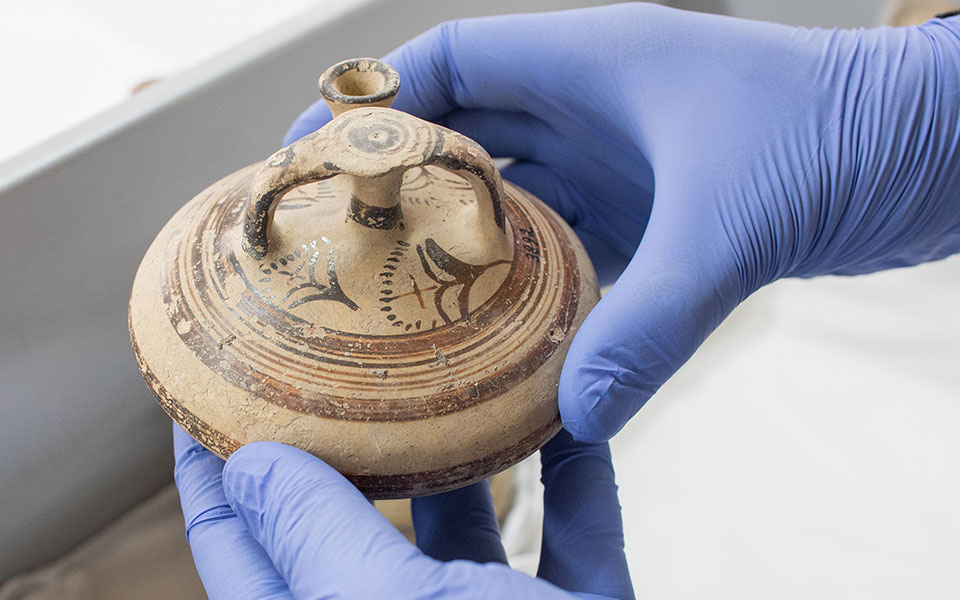When the decanter opens, close your eyes. Let the scent of a rose take you back millennia in time. The scent of antiquity, “Rodo” (Rose) has the feel of a primitive scented oil and is among the exhibits in the temporary exhibition hall of the National Archaeological Museum, adding another facet to a never-ending search.
The scent was created in the context of “Countless Aspects of Beauty”, the museum’s latest major temporary exhibition, the last instalment in a trilogy of exhibitions to celebrate the museum’s 150th year. The exhibition opened to the public on Saturday, May 26.
The “optimistic” exhibition, as the museum’s director, Dr Maria Lagogianni-Georgakarakos describes it, explores the archaeology of the senses, revealing a diversity that is underpinned by something universal. There are many expressions of beauty that have been preserved to this day and the exhibition covers a period from the Neolithic to Late Antiquity through 340 artifacts from the museum’s collections.

© Margarita Nikitaki
The star of the exhibition is that multi-faceted expert in love and beauty, the goddess Aphrodite who “welcomes” visitors half nude, draped in a himation (a type of ancient Greek garment) and accompanied by a sleeping Eros. All around her, a host of artworks shed light on diverse aspects of beauty, including grooming and fashion through the ages among others. But no historical find – not even the exhibition’s ancient stirrup jars that were once used to store perfumes – carries a trace of the scents of antiquity.
The idea to create ‘ancient perfumes’ in an attempt to approach antiquity through the sense of olfaction came from Lagogianni. Researchers from the R&D arm of the cosmetics company Korres took on the task of creating three scented oils using the same raw materials and methodologies as ancient perfumers.
The two sides began discussing the project in January of 2017. “Certainly the scent operates as a means of communication – we fall in love through sight, but also possibly through scent,” Lagogianni says, adding that the attempt to recreate an ancient perfume as part of the exhibition was part of an effort to “restore forgotten sensory experiences of the ancient world and to offer an original experience.”

© Margarita Nikitakis
Experimental Archaeology
The valuable scented oils were indicators of social status and were aimed at men as well as women. They were used by athletes and sporting events, and by citizens during major events including childbirth, weddings and burying the dead.
As for the “trendsetting” Aphrodite, she would doubtlessly be willing to pull out the cork and try “Rose”, the first of the three perfumes (together with “Sage” and “Coriander”) that were created through experimental archaeology.
“It is one of the most magical moments that we have experienced as scientists and as Greeks,” says Lena Korres, co-founder and head of the Innovation Center of Korres in a meeting room in the company’s factory in Oinofyta.
“We discovered, for example, that they would alter the chemical structure of the oils to make them suitable to be scented. We discovered knowledge that we don’t use in biochemistry and which existed so many thousands of years ago.”

© Margarita Nikitaki

© Margarita Nikitaki
In Oinofyta, Iordanis Samanidis, a chemist who specializes in the development and production of raw materials, began to cover the “gap [in knowledge] from the Bronze Age, from historical sources.” He studied Linear B tablets (the first written form of the Greek language) – the “ledgers” of the storehouse keepers in the Mycenaean palaces, where ingredients such as wine, wool, and honey were earmarked for the production of aromatic products.
To probe the use of the raw materials, he studied more modern texts, reaching the Library of Reythmno in Crete. His sources included modern researchers such as Ellen Douglas Hamill Foster (author of The Manufacture and Trade of Mycenean Perfumed Oil), Cynthia Wright Shelmerdine (The Perfume Industry of Mycenaean Pylos), Michalis Vogiatzis and Ioannis Fappas. Ancient scholars also lent their knowledge such as Theophrastus (Concerning Odors) and Dioscorides (On Medical Material).

© Margarita Nikitaki
Samanidis settled on three scents, on (favorite) rose, sage (making use of some creative freedom) and coriander. In a specially designed space, the recipe begins with a basic method of infusion, where extra virgin olive oil and water were boiled, while at the same time ground nutsedge (which was sourced from the island of Amorgos) and wine were used to make a paste.This mix of raw materials was then filtered, resulting in an oil-based solvent with the scent of nutsedge. The next step was the add rose oil (in ancient times they would have used fresh petals) for the aroma and powdered alkanna root for a more intense color.
“Sage” and “Coriander” will be revealed during the course of the exhibition together with other surprise exhibits. At the same time the Rose perfume will be packaged in a very limited number of bottles, as Sophia Zisimou, head of the company’s R&D department has taken on the task of ‘translating’ the aromatic oil into a cosmetic, in cooperation with the Greek perfumer Sophia Koronaiou, who works in Grasse, the historic heart of the French perfume industry.
In the meantime Rose, (a single-dimensional scent, without the familiar ‘notes’ that later became established in perfumery) will offer those exploring beauty in the Athenian museum a unique experience: one of the innumerable ‘forgotten’ aspects of Beauty.












